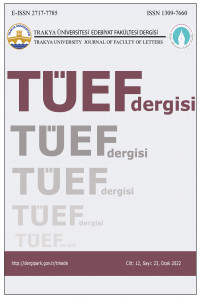Öz
Transhumanism is a philosophy based on the idea of enhancing the physical, intellectual and psychological capacity of human beings through the direct use of science and technology. Because transhumanism aims to ensure super longevity, super intelligence and super well-being, it is said that it will provide a more liberating atmosphere for human beings by elevating the current human condition. In Spike Jonze’s film her (2013), transhumanist technologies seem to present a peaceful society by focusing on the inhabitants’ well-being. However, in this futuristic society where advanced AI technology and personal letter writing service are widespread, human beings are over-controlled in a subtle way by manufacturing consent as Antonio Gramsci uses to explain the concept of hegemony. So transhumanism does not present a free environment in this futuristic society; instead it disguises the control mechanism through these technologies. The aim of this article is to explore how human beings are controlled by transhumanist technologies subtly under the name of providing super well-being.
Anahtar Kelimeler
Kaynakça
- BAUDRILLARD, Jean. (1983). The Precession of Simulacra. In ( P. Foss, P. Patton and P. Beitchman Trans.), Simulations (pp. 1-79). New York: Columbia UP. (Original work published in 1981).
- BOSTROM, Nick. (2003). The Transhumanist FAQ. World Transhumanist Association, 1-56. Retrieved October 7, 2016 from [URL: https://www.nickbostrom.com/views/transhumanist.pdf ]
- BOSTROM, Nick. (2005). Transhumanist Values. Review of Contemporary Philosophy, 4, 1-11. Retrieved October 7, 2016 from [URL: https://www.nickbostrom.com/ethics/values.html]
- GRAMSCI, Antonio. (1992). Selections from the Prison Notebooks. ( Q. Hoare and G. N. Smith. Trans.). New York: International P. (Original work published in 1948).
- HARRIS, Rachel Lee. (2014). Clothes and Character: ‘Her’. The New York Times. Retrieved Nov. 20, 2020 from [URL: https://carpetbagger.blogs.nytimes.com/2014/02/21/clothes-and-character-her/?_r=0]
- IRIGARAY, Luce. (1985). This Sex Which is not One. This Sex Which is not One. (C. Porter and C. Burke. Trans.) New York: Cornell UP. (Original work published in 1977).
- IVANCHIKOVA, Alla. (2016). Machinic Intimacies and Mechanical Brides: Collectivity between Prosthesis and Surrogacy in Jonathan Mostow's Surrogates and Spike Jonze's Her. Camera Obscura: Feminism, Culture, and Media Studies, 31(1), 65–91. Retrieved February 10, 2019 from [URL: https://doi.org/10.1215/02705346-3454430]
- JONZE, Spike. (2013). Her. Retrieved May 16, 2016 from [URL:http://www.screenplaydb.com/film/scripts/her.pdf]
- PITTS, Victoria. (2005) Feminism, Technology and Body Projects. Women’s Studies, 34, 229-247. Retrieved February 15, 2019 from [URL: https://doi.org/10.1080/00497870590964129]
- SABBADINI, Andrea. (2017). Intimacy in a Virtual World: Some Reflections on Spike Jonze’s film Her. Rom J Psychoanal, 10 (1), 131-138.
- Humanity Plus (2009). “Transhumanist Declaration.” Retrieved Sept. 20, 2016 from [URL: www.humanityplus.org/philosophy/transhumanist- declaration/ ]
Öz
Transhümanizm, bilim ve teknolojinin doğrudan kullanımı yoluyla insanın fiziksel, zihinsel ve psikolojik kapasitesini geliştirme fikrine dayanan bir felsefedir. Transhümanizmin, süper uzun ömür, süper zeka ve süper refah sağlamayı amaçladığı için, mevcut insanlık halini yükselterek insanlar için daha özgürleştirici bir atmosfer sağlayacağı söyleniyor. Spike Jonze’nin her (2013) adlı filminde, transhümanist teknolojiler, insanların refahına odaklanarak huzurlu bir toplum sunmaktadır. Ancak, gelişmiş yapay zeka teknolojisinin ve kişisel mektup yazma hizmetinin yaygın olduğu bu fütüristik toplumda insanlar, Antonio Gramsci'nin hegemonya kavramında sözünü ettiği gibi, farkında olmadan kontrol edilmektedir. Dolayısıyla, transhümanizm bu fütürist toplumda özgür bir ortam sunmak yerine bu teknolojiler aracılığıyla kontrol mekanizmasını gizlemektedir. Bu makalenin amacı, süper refah sağlama adı altında, insanoğlunun transhümanist teknolojiler tarafından nasıl fark edilmeden kontrol edildiğini incelemektir.
Anahtar Kelimeler
Kaynakça
- BAUDRILLARD, Jean. (1983). The Precession of Simulacra. In ( P. Foss, P. Patton and P. Beitchman Trans.), Simulations (pp. 1-79). New York: Columbia UP. (Original work published in 1981).
- BOSTROM, Nick. (2003). The Transhumanist FAQ. World Transhumanist Association, 1-56. Retrieved October 7, 2016 from [URL: https://www.nickbostrom.com/views/transhumanist.pdf ]
- BOSTROM, Nick. (2005). Transhumanist Values. Review of Contemporary Philosophy, 4, 1-11. Retrieved October 7, 2016 from [URL: https://www.nickbostrom.com/ethics/values.html]
- GRAMSCI, Antonio. (1992). Selections from the Prison Notebooks. ( Q. Hoare and G. N. Smith. Trans.). New York: International P. (Original work published in 1948).
- HARRIS, Rachel Lee. (2014). Clothes and Character: ‘Her’. The New York Times. Retrieved Nov. 20, 2020 from [URL: https://carpetbagger.blogs.nytimes.com/2014/02/21/clothes-and-character-her/?_r=0]
- IRIGARAY, Luce. (1985). This Sex Which is not One. This Sex Which is not One. (C. Porter and C. Burke. Trans.) New York: Cornell UP. (Original work published in 1977).
- IVANCHIKOVA, Alla. (2016). Machinic Intimacies and Mechanical Brides: Collectivity between Prosthesis and Surrogacy in Jonathan Mostow's Surrogates and Spike Jonze's Her. Camera Obscura: Feminism, Culture, and Media Studies, 31(1), 65–91. Retrieved February 10, 2019 from [URL: https://doi.org/10.1215/02705346-3454430]
- JONZE, Spike. (2013). Her. Retrieved May 16, 2016 from [URL:http://www.screenplaydb.com/film/scripts/her.pdf]
- PITTS, Victoria. (2005) Feminism, Technology and Body Projects. Women’s Studies, 34, 229-247. Retrieved February 15, 2019 from [URL: https://doi.org/10.1080/00497870590964129]
- SABBADINI, Andrea. (2017). Intimacy in a Virtual World: Some Reflections on Spike Jonze’s film Her. Rom J Psychoanal, 10 (1), 131-138.
- Humanity Plus (2009). “Transhumanist Declaration.” Retrieved Sept. 20, 2016 from [URL: www.humanityplus.org/philosophy/transhumanist- declaration/ ]
Ayrıntılar
| Birincil Dil | İngilizce |
|---|---|
| Bölüm | Araştırma Makaleleri |
| Yazarlar | |
| Yayımlanma Tarihi | 27 Ocak 2022 |
| Gönderilme Tarihi | 19 Haziran 2021 |
| Yayımlandığı Sayı | Yıl 2022 Cilt: 12 Sayı: 23 |


